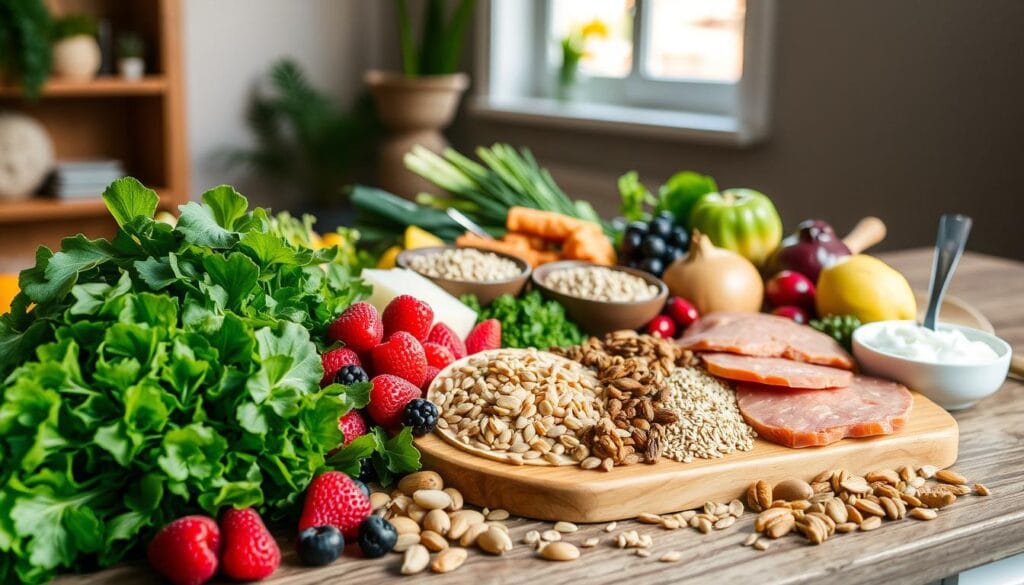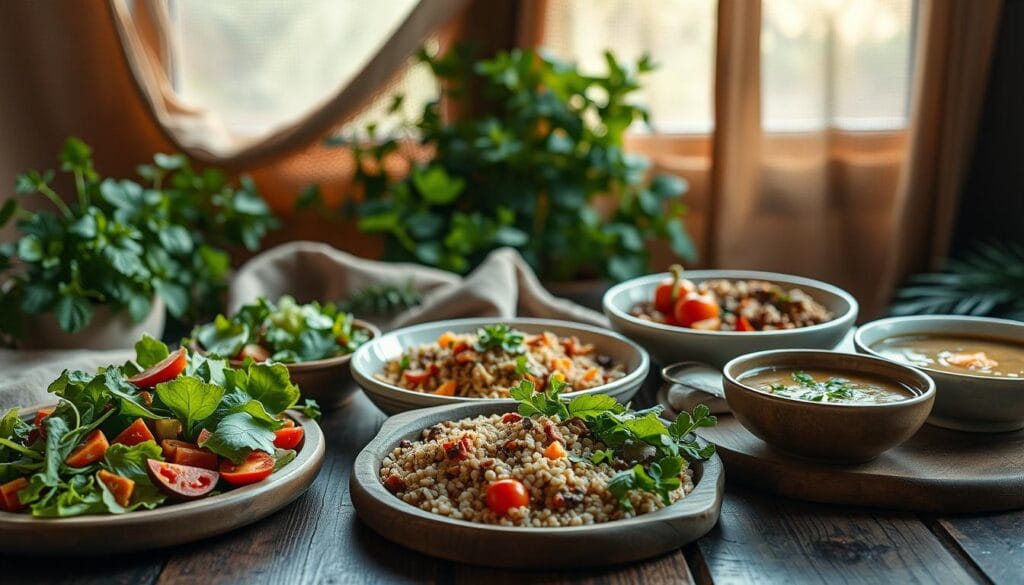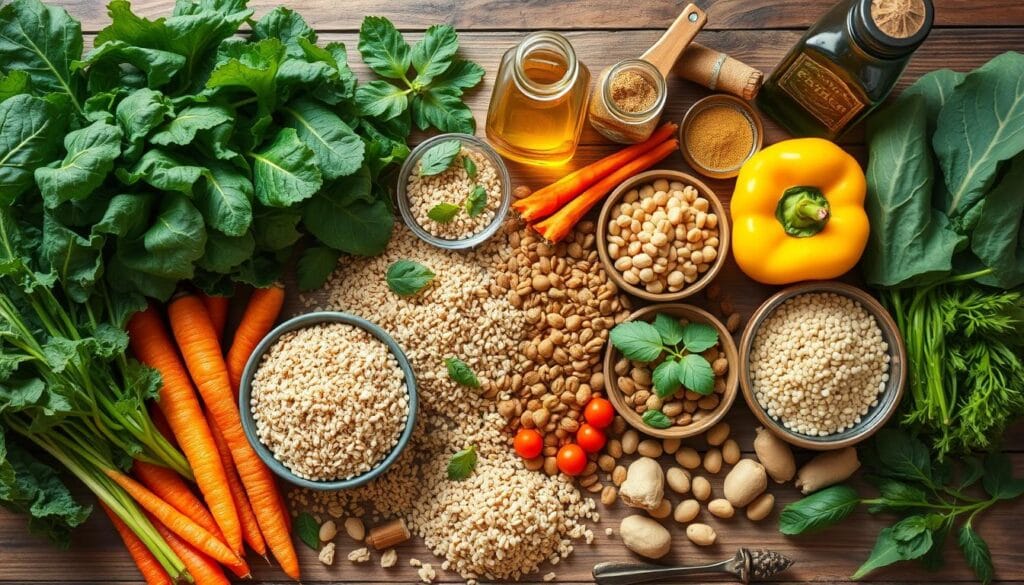Are you looking for delicious and nutritious meal ideas that fit your busy lifestyle? Look no further! This article introduces you to an exciting collection of 10 must-try Roam Diet recipes, designed to provide balanced nutrition without compromising on flavor.
These easy-to-make, nutrient-packed meals are perfect for anyone seeking to enhance their protein intake and incorporate more whole ingredients like fresh vegetables and lean proteins. Whether you’re a busy professional or an active individual, these recipes will transform your cooking game with simple, balanced, and satisfying food options.
Each recipe is crafted to cater to your schedule, ensuring you can enjoy flavorful and healthy meals even on the go. By focusing on whole, unprocessed foods, these dishes offer a clear path to better nutrition, backed by insights from trusted sources.
Get ready to discover how these recipes can elevate your meal prep and provide the energy you need to thrive throughout your day!
Table of Contents
Understanding the Roam Diet Philosophy
The Roam Diet is a modern approach to eating that focuses on simplicity and balance. It’s designed for individuals who want to enjoy nutritious meals without sacrificing flavor or convenience. This philosophy emphasizes whole, unprocessed foods, making it an excellent choice for those with active lifestyles.
What Is the Roam Diet?
The Roam Diet is centered around whole ingredients like lean proteins, fresh vegetables, and whole grains. It encourages mindful eating and flexibility, allowing you to indulge occasionally while maintaining a healthy balance. This approach is backed by insights from trusted sources, ensuring you get the most out of your meals.
Core Principles of Balanced Nutrition
At its core, the Roam Diet promotes balanced nutrition through simple, satisfying meals. It focuses on:
| Component | Importance | Benefits |
|---|---|---|
| Lean Proteins | Essential for muscle repair and energy | Supports muscle growth and satisfaction |
| Fresh Produce | Rich in vitamins and minerals | Boosts immune function and digestion |
| Whole Grains | Provides sustained energy | Aids in maintaining steady blood sugar |
| Healthy Fats | Crucial for brain health | Supports heart health and nutrient absorption |
By focusing on these elements, the Roam Diet helps you maintain steady energy levels and overall well-being. It’s a practical approach that fits seamlessly into your daily routine, offering both health benefits and delicious meals.

Balanced Nutrition Through a Wholesome Diet
Understanding how proteins, carbs, and fats work together is key to creating meals that fuel your day. A balanced diet isn’t just about eating the right foods—it’s about how these nutrients interact to support your energy levels and overall health.
The Role of Proteins, Carbs, and Fats
Protein is essential for muscle repair and growth, making it a cornerstone of your meals. Lean proteins, such as chicken or fish, provide sustained energy and keep you feeling full longer.
Carbs, especially complex ones like rice, are your body’s primary energy source. They help you power through your day and support brain function. Including a variety of whole grains ensures you get essential vitamins and minerals.
Fats play a crucial role in nutrient absorption and brain health. Healthy fats, like those found in avocados, help your body absorb vitamins and maintain heart health.
| Macronutrient | Role | Benefits |
|---|---|---|
| Proteins | Muscle repair and growth | Sustained energy, muscle maintenance |
| Carbs | Energy production | Supports physical and mental activity |
| Fats | Nutrient absorption | Heart health, brain function |
By balancing these elements, you create meals that are not only delicious but also nutritionally complete, helping you maintain steady energy and support your overall well-being.

Essential Ingredients for Roam Diet Recipes
Building a balanced meal starts with the right ingredients. The Roam Diet focuses on whole, nutrient-dense foods that provide sustained energy and support overall health.
Core Ingredients to Stock Your Kitchen
Your pantry should be filled with fresh vegetables, lean proteins, and whole grains. These form the foundation of every meal. Fresh produce like leafy greens and colorful vegetables ensures you get essential vitamins and minerals. Lean proteins such as chicken or fish provide sustained energy and muscle support. Whole grains like quinoa and brown rice offer complex carbs for steady energy levels.
Optional Add-Ins for Flavor and Texture
Add a little extra with healthy fats, herbs, and spices. Avocado, nuts, and seeds bring in healthy fats, while fresh herbs add natural flavor without extra calories. These additions not only enhance taste but also boost the nutritional value of your meals.
| Ingredient | Role | Benefits |
|---|---|---|
| Leafy Greens | Packed with vitamins and minerals | Supports immune function and digestion |
| Quinoa | Complete protein and fiber source | Provides steady energy and aids digestion |
| Avocado | Rich in healthy fats | Supports heart health and nutrient absorption |
Stocking your kitchen with these ingredients makes healthy cooking quick and convenient. They offer versatility and nutritional benefits, helping you create balanced meals with ease.

Planning Your Meals for Success
Planning your meals is a cornerstone of maintaining a balanced and nutritious diet. By organizing your meals in advance, you can save time, reduce stress, and ensure that every dish you prepare is both healthy and delicious. This section will guide you through practical strategies to streamline your meal planning process, helping you create meals that are both nourishing and convenient.
Meal Prep Strategies to Save Time
A well-structured meal plan can make a significant difference in your daily routine. Start by setting aside time each week to plan your meals for the next few days. Consider your schedule, dietary preferences, and the ingredients you have on hand. This approach not only saves time but also helps reduce food waste and ensures that each meal is balanced and satisfying.
One effective tip is to prepare components of your meals in advance. Chop vegetables, marinate proteins, and cook grains ahead of time. These pre-prepared elements can be assembled quickly when you’re ready to eat, making mealtime efficient and stress-free. Additionally, experimenting with different ingredient combinations can keep your meals interesting and tailored to your tastes.
Proper planning also enhances the nutritional value of your meals. By thoughtfully selecting ingredients and balancing macronutrients, you can create dishes that are both nourishing and flavorful. This mindful approach to meal preparation ensures that your diet remains varied, satisfying, and aligned with your health goals.
Quick and Easy Recipes to Kickstart Your Journey
Discover how vibrant salads and nutritious bowls can transform your meal routine. These recipes are designed to be quick, flavorful, and packed with nutrients, perfect for those with busy schedules.
Recipe Spotlight: Vibrant Salads & Nutritious Bowls
These recipes are crafted to be simple yet balanced, focusing on fresh vegetables and lean proteins. They offer a perfect blend of protein and veggies, making each meal satisfying and healthy.
- Explore a variety of easy-to-make dishes that combine fresh ingredients for maximum flavor.
- Learn how to mix proteins like grilled chicken or tofu with colorful veggies for a nutritious meal.
- Get practical tips to customize each recipe to your taste, ensuring every meal is efficient and delicious.
| Recipe | Protein Source | Benefits |
|---|---|---|
| Grilled Chicken Salad | Chicken Breast | High in protein, supports muscle repair |
| Quinoa Bowl | Quinoa | Complete protein, aids digestion |
| Avocado Tuna Bowl | Canned Tuna | Rich in healthy fats and protein |
These quick recipes serve as a gateway to healthier eating habits, offering both convenience and nutrition. Start your journey with these simple, balanced meals and enjoy the benefits of a nutritious diet.
Cooking Techniques and Time-Saving Hacks
Mastering efficient cooking techniques can transform your kitchen experience, making meal prep faster and more enjoyable. Whether you’re a novice or an experienced cook, these tips will help you create delicious, balanced meals with ease.
Essential Cooking Techniques to Master
Sautéing and steaming are foundational methods that preserve the nutrients in your food while adding flavor. Sautéing quickly cooks ingredients over high heat, locking in their natural flavors, while steaming gently cooks vegetables without losing essential vitamins and minerals.
Proper seasoning is another key element. Start with a light hand and adjust to taste, using herbs and spices to enhance the dish without overpowering it. This approach ensures your meals are both flavorful and balanced.
| Technique | Benefit | Tip |
|---|---|---|
| Sautéing | Preserves flavor and nutrients | Use a hot pan with a small amount of oil |
| Steaming | Retains vitamins and minerals | Don’t overcrowd the steamer basket |
| Seasoning | Enhances flavor naturally | Add spices gradually and taste |
Expert Tips for Streamlined Cooking
Prepping ingredients in advance saves time during cooking. Chop vegetables and marinate proteins beforehand to make meal assembly quick and efficient. Experimenting with new techniques keeps your meals exciting and tailored to your preferences.
Incorporating Protein and Healthy Fats in Every Dish
Protein and healthy fats are essential for creating meals that are both satisfying and nutritious. These nutrients work together to provide sustained energy and support overall health. Understanding how to balance them in your dishes can elevate your cooking and ensure every meal is nourishing.
Best Protein Sources for Sustained Energy
Protein is a cornerstone of a balanced meal, helping to repair muscles and keep you energized throughout the day. Chicken breast and tofu are excellent choices, offering high-quality protein without excess fat. Fatty fish like salmon also provide a boost of omega-3 fatty acids, which support heart health and brain function. For plant-based options, lentils and quinoa are great sources of protein and fiber, making them ideal for vegetarian meals.
The Importance of Nutrient-Dense Fats
Healthy fats are vital for absorbing vitamins and maintaining cell health. Avocados, nuts, and olive oil are rich in monounsaturated fats, which can improve cholesterol levels and reduce heart disease risk. These fats also add flavor and texture to your dishes, making meals more enjoyable. Pairing proteins with healthy fats creates balanced meals that provide long-lasting energy and satisfaction.
By combining protein and healthy fats, you create meals that are not only delicious but also support your overall well-being. This balanced approach ensures you stay energized and focused, making it easier to maintain a healthy lifestyle.
Customizing Your Roam Diet Recipes
Personalizing your meals is a great way to keep your diet engaging and tailored to your preferences. Whether you’re managing dietary restrictions or exploring new flavors, customization is key to maintaining a balanced and satisfying diet.
Adapting for Vegan, Gluten-Free, and Low-Carb Options
Easily modify your recipes to suit specific dietary needs. For vegan meals, swap eggs with flaxseed or use plant-based proteins like tofu or tempeh. Opt for gluten-free grains such as quinoa or brown rice to accommodate gluten-free requirements. For low-carb options, consider cauliflower rice or zucchini noodles as creative alternatives to traditional carbs.
Seasonal and Flavor Variations
Incorporate seasonal produce to keep your meals fresh and exciting. During summer, try grilled vegetables or refreshing salads. In colder months, hearty soups or roasted dishes can be comforting. Experiment with herbs and spices to add unique flavors, ensuring every meal is both nutritious and delicious.
By making these simple adjustments, you can enjoy a variety of meals that cater to your lifestyle and preferences without compromising on nutrition or taste.
Mastering Meal Presentation and Serving Ideas
Elevate your dining experience with these expert tips on meal presentation and serving ideas. Presentation is more than just aesthetics; it enhances the enjoyment of your food and makes every meal feel special.
Garnishing Tips and Dishware Selection
Start by choosing the right dishware. Select plates and bowls that complement the colors of your food. For example, a vibrant salad looks stunning on a neutral-toned plate. Consider the shape and size to ensure your dish isn’t overwhelmed by the plate.
- Use fresh herbs like parsley or basil for a pop of color and freshness.
- Add a drizzle of sauce or dressing to create visual appeal.
- Experiment with creative plating ideas, like arranging ingredients in a pattern.
A well-presented meal can make even simple dishes look gourmet. By paying attention to these details, you can create meals that are as visually appealing as they are delicious.
Storing and Reheating Your Healthy Meals
Properly storing and reheating your meals is crucial for maintaining their flavor and nutritional value. This section will guide you through the best practices for keeping your food fresh and safe to eat.
Best Practices for Refrigeration and Freezing
To keep your meals fresh, refrigerate them within two hours of cooking. Use airtight containers to prevent contamination and spoilage. The FDA recommends storing leftovers in the fridge at 40°F or below. For longer storage, freezing is a great option. Place portions in freezer-safe containers or bags at 0°F or below.
- Label containers with the date to ensure you use the oldest items first.
- Store high-risk foods like meats and dairy separately to prevent cross-contamination.
Effective Reheating Methods
Reheating should be done safely to avoid foodborne illness. Heat meals to an internal temperature of 165°F. Here are some methods:
- Stovetop: Reheat on low-medium heat, stirring occasionally.
- Microwave: Use a microwave-safe container, cover, and heat in short intervals.
- Oven: Preheat to 350°F, place in a covered dish, and heat until hot.
Separate meal components before reheating to maintain texture and flavor. Add a splash of water or broth if needed to prevent drying out.
By following these tips, your meals will stay fresh, nutritious, and delicious. Proper storage and reheating ensure your food remains safe and enjoyable.
Troubleshooting Common Recipe Challenges
Even the most experienced cooks encounter challenges in the kitchen. Whether it’s overcooking ingredients or struggling with flavor balance, these issues can affect the quality of your meals. However, with the right strategies, you can easily overcome these common pitfalls and ensure your dishes turn out delicious and nutritious.
Avoiding Overcooking and Balancing Flavors
One of the most frequent mistakes is overcooking, which can make your food tough and less flavorful. To avoid this, use a timer and keep an eye on your ingredients as they cook. For proteins like chicken or fish, ensure they reach a safe internal temperature without overcooking. This helps retain moisture and flavor.
When it comes to seasoning, start with small amounts and taste as you go. You can always add more, but it’s harder to remove excess seasoning. Balancing flavors is key to a great dish. If a recipe tastes too salty, try adding a squeeze of fresh citrus or a splash of vinegar to restore balance.
- Use a timer to prevent overcooking proteins and vegetables.
- Season gradually and taste as you adjust.
- Add acidic ingredients like lemon juice or vinegar to balance flavors.
By mastering these simple tips, you can troubleshoot common recipe challenges and enhance your cooking skills. Remember, practice makes perfect, and even small adjustments can make a big difference in the quality of your meals.
Expert Pro Tips and Creative Variations for Roam Diet Recipes
Elevate your cooking with expert advice and innovative twists that bring out the best in your meals. These tips and variations will help you refine your recipes and keep your dishes fresh and exciting.
Practical Advice from Nutrition Experts
Nutrition experts suggest focusing on balance and variety. “The key to a successful meal is harmonizing flavors and textures while ensuring nutritional value,” notes a leading dietitian. Here are some actionable tips:
- Start with small adjustments to recipes to enhance flavor without compromising nutrition.
- Experiment with different proteins like chicken, tofu, or fish to vary your meals.
- Incorporate healthy fats such as avocado or nuts to boost satisfaction and nutrient absorption.
Innovative Twists to Refresh Classic Dishes
Add a creative touch to your favorite recipes with these expert techniques:
| Tip | Technique | Benefit |
|---|---|---|
| Protein Swap | Replace chicken with tofu or legumes | Increases plant-based protein options |
| Fat Enhancement | Add a drizzle of olive oil or nuts | Boosts healthy fats and flavor |
| Flavor Burst | Use herbs like basil or rosemary | Enhances taste naturally |
These simple changes can transform a classic dish into a new favorite, keeping your meals exciting and nutritious.
Conclusion
In conclusion, the Roam Diet offers a practical and flavorful path to balanced nutrition, making it easy to enjoy healthy meals without spending hours in the kitchen. By focusing on nutrient-dense ingredients and simple cooking techniques, you can create dishes that provide sustained energy and support your overall well-being.
Remember, the key to a successful meal plan is balance and variety. Start experimenting with the recipes and tips provided, and don’t hesitate to adapt them to your preferences. Small changes in your cooking habits can lead to lasting improvements in your health and energy levels.
With these accessible recipes, you’re empowered to take control of your nutrition and embrace a healthier lifestyle. Begin your journey today and experience how these meals can transform your daily routine, providing the nourishment you need to thrive.
FAQ
How does the Roam Diet help maintain energy levels throughout the day?
What are the best sources of protein in a meal?
How can I incorporate more healthy fats into my diet?
What are the benefits of including carbs in my meals?
How can I meal prep to save time during the week?
What are some tips for a balanced diet?
How does the Roam Diet support overall health?
There are no reviews yet. Be the first one to write one.

